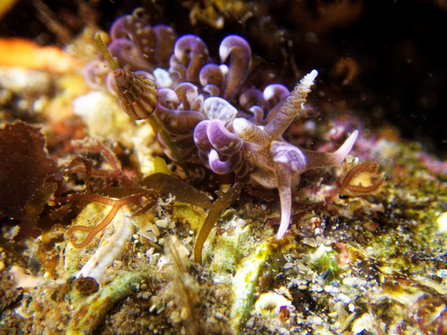Usually resident in the Caribbean, Mediterranean, and along the western Atlantic, records of the nudibranch Spurilla neapolitana have only recently been edging northwards. Until now, its most northerly sighting was in Brest, France, in August 2025.
Ranging in colour from pink to orange, this sea slug is known for the flattened, long, thick outgrowths on its body (which give rise to its French common name, limace à bigoudis, roughly translated as “hair curler slug”).
Charlotte said:
“I have travelled down to Cornwall to take part in Shoresearch Week annually since 2019. Prisk Cove is one of my favourite shores and, as ever, it was low tide and I was looking through the seaweeds along a reef when this little nudibranch caught my eye.
“It was less than 10mm long and looked similar to a slug I have seen before with its curled cerata, although this one was much more purple.
“It’s quite difficult to see the back of the camera underwater in bright sunlight, so I took a few shots and thought no more of it. It wasn’t until later that evening when I was looking at the photos on a computer screen, that I realised it was in fact something I’d never seen before.
It’s incredibly exciting to see nudibranchs on the shore, and to discover a species new to the UK is a real thrill.
“I’m so grateful for the support and encouragement of everyone involved in Cornwall Wildlife Trust’s Shoresearch Week programme. Five consecutive days of shore surveys is hard work, but it is one of the highlights of my year!”

